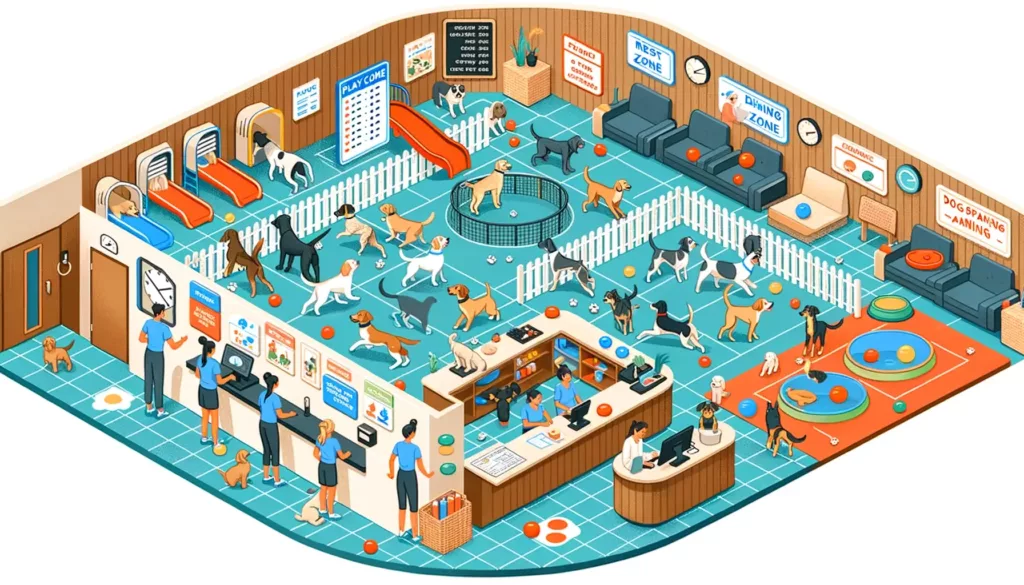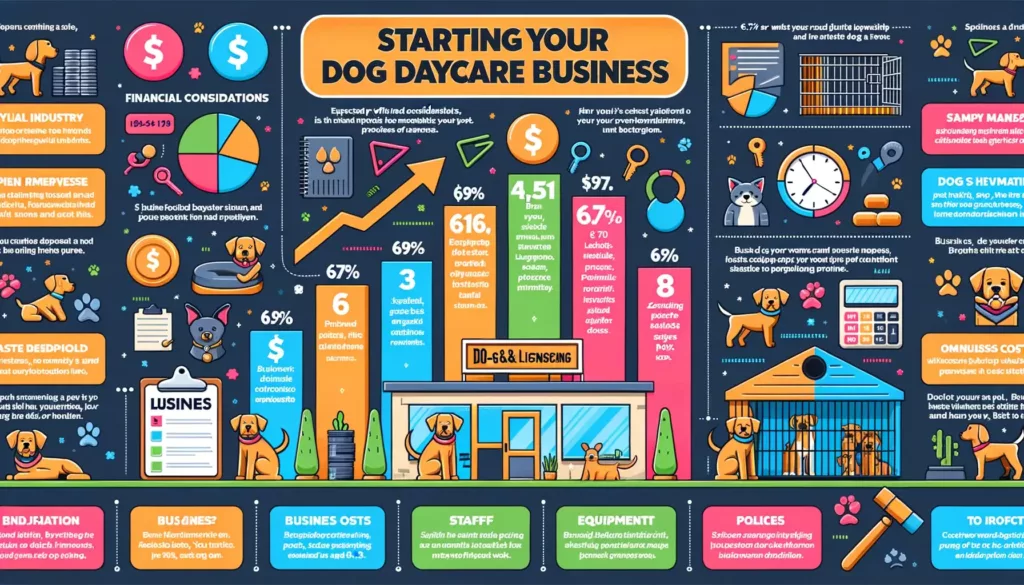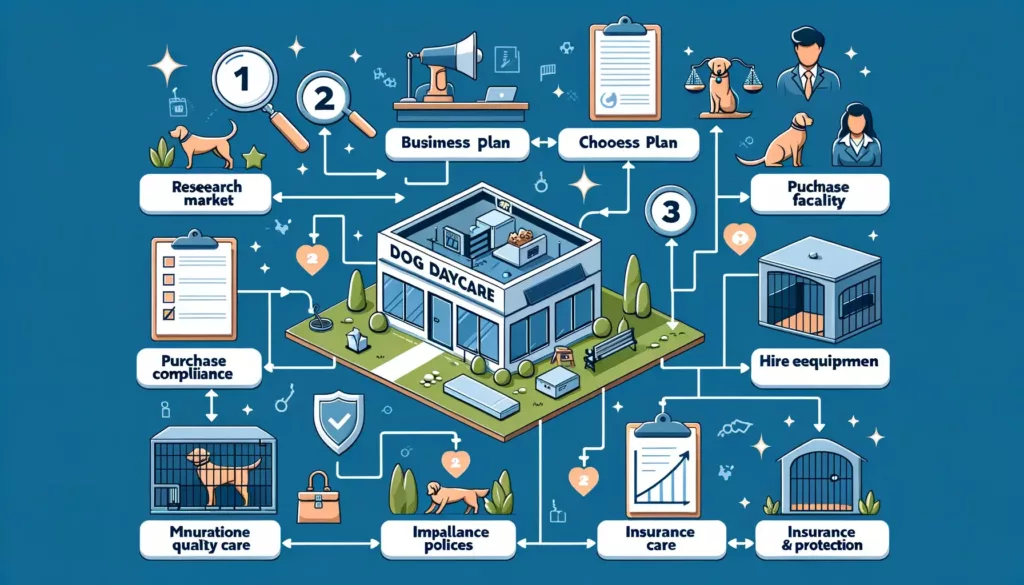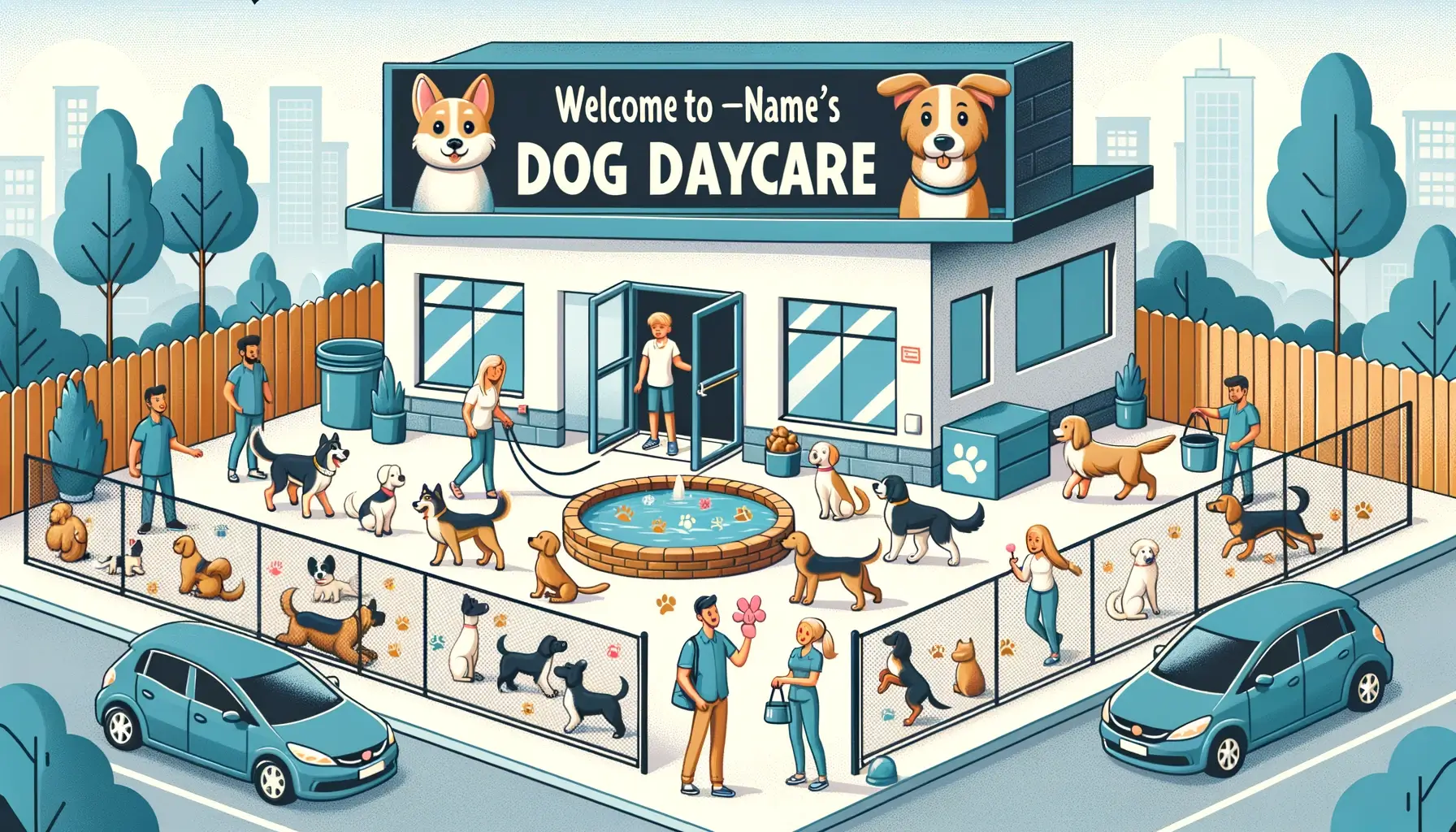Starting a dog daycare can be an incredibly rewarding experience for any dog lover. As the pet industry continues to grow, dog daycares have become an increasingly popular pet care service for busy owners who need reliable canine care while they are at work or traveling.
While dog daycares require plenty of research, planning, and preparation, they offer the chance to turn your passion for dogs into a profitable business. Follow this comprehensive guide to get your own dog daycare up and running smoothly.

Introduction to the Thriving Pet Care Industry
The pet industry has been growing steadily for years. According to the American Pet Products Association (APPA), annual spending on pets in the US reached $103.6 billion in 2020, up from $97.1 billion in 2019. With over 90 million pet dogs in the US, dog owners are a huge driver of this spending.
As owners increasingly view pets as family, they are more willing to invest in services like dog daycares that provide premium care. The APPA found that spending on pet services like grooming, boarding, and dog walking grew to $21.47 billion in 2020. With such strong industry growth, a well-run dog daycare can be highly profitable.
Some key statistics on the booming pet industry:
| Industry Size | $103.6 billion in 2020 |
|---|---|
| Number of Pet Dogs | 90 million+ |
| Pet Services Spending | $21.47 billion |
| YoY Growth | 6.7% from 2019-2020 |
With these figures forecast to rise steadily in coming years, the opportunities in the pet care space are immense for aspiring entrepreneurs. Dog daycares in particular are an increasingly popular segment catering to busy urban dog owners. Now is an opportune time to capitalize on this growth.
Key Financial Considerations Before Opening
Starting any new business requires thorough financial planning. Take time to analyze the profitability and costs associated with opening a dog daycare in your area.
Calculate Expected Profit Margins

Research competitors to estimate potential pricing for your services. Typical rates range from $15-40 per day depending on location. Estimate your max capacity based on facility size, and multiply by your daily rate to get potential monthly revenue.
Factor in all operating expenses like rent, payroll, insurance, supplies, and utilities. This will give you an idea of your profit potential and business model viability. Most successful dog daycares target at least a 20% profit margin.
When calculating your expected profit margin, be sure to account for:
- Size of facility and max dog capacity
- Competitor pricing for daycare, boarding, grooming
- Your chosen pricing structure
- Monthly sales volume projections
- All operating costs like rent, staff, supplies
- One-time startup costs
Having a clear sense of your expected revenues versus costs is crucial for setting prices that will deliver your ideal profit margin. Adjust pricing as needed to hit your profitability goals.
Understand Startup Costs

While costs vary, most dog daycares require around $35,000 to $150,000 in startup capital. Larger facilities, extensive outdoor space, and high-end amenities can drive costs upward.
Key startup expenses include:
- Facility rental deposit and buildout/renovations
- Insurance, permits, licenses
- Staff wages
- Commercial cleaning equipment
- Furniture like crates, pens, flooring
- Toys, leashes, bowls, specialty amenities
- Reservation/record-keeping software
- Initial marketing costs
Some sample startup costs:
| Expense | Cost |
|---|---|
| Facility deposit | $5,000 |
| Buildout and renovations | $15,000 |
| Permits and licenses | $2,000 |
| Insurance (1st year) | $5,000 |
| Staff wages (first 3 months) | $30,000 |
| Equipment and supplies | $10,000 |
| Software | $3,000 |
| Initial marketing | $5,000 |
| Total | $75,000 |
Take out loans cautiously, as debt repayment will reduce profitability. Have at least 6 months of operating expenses saved as a financial buffer.
Pick the Right Business Structure
You must choose a formal business structure before opening your dog daycare. Common options include:
- Sole proprietorship
- Partnership
- Limited liability company (LLC)
- S Corporation
LLCs and S Corps limit your personal liability but require more paperwork. Consult an accountant to determine the best structure for your goals and situation.
Here are some key considerations when choosing a business structure:
Sole Proprietorship
- Simplest structure with minimal paperwork
- No separate business entity – you are personally liable
- Pass-through taxation to your personal returns
- Easy to form and dissolve
Partnership
- Allows multiple owners to share ownership
- Owners have unlimited personal liability
- Must have partnership agreement
- Pass-through taxation to partners
LLC
- Separate legal entity protects your personal assets
- Allows pass-through taxation as sole prop/partnership
- Requires articles of organization and operating agreement
- Annual fees and formalities for upkeep
S Corporation
- Shareholders have limited liability protection
- Considered a separate legal entity
- Must file articles of incorporation
- Annual meetings and formal corporation upkeep
- Subject to double taxation in some cases
Follow Pet Industry Rules and Regulations
Dog daycares must adhere to various legal and licensing requirements. Be sure to research and comply with all relevant regulations in your state and municipality.
Typical legal needs include:
- Business license
- Kennel permit or commercial kennel license
- Tax IDs like a Federal EIN
- Zoning approval
- Liability insurance (often $1 million minimum)
- Adherence to labor laws
Kennel licenses can take months to obtain, so start the application process early. Work with a lawyer to ensure full compliance. Consider pet business insurance for added protection.
Some common pet business licenses and permits:
| Permit/License | Time to Obtain | Cost |
|---|---|---|
| Business license | 4-6 weeks | $50-$100 |
| Kennel permit | 12 weeks | $250 |
| EIN | 1-2 weeks | Free |
| Insurance | 1 week | Varies |
| Zoning approval | 6-8 weeks | $100 |
Failing to properly research and obtain required licensing can result in hefty fines or even force you to close until compliant. Leave ample time to go through all required approval processes.
Choose the Perfect Facility
Your facility’s layout, amenities and location will heavily influence the client and pet experience. Look for a space with:
- Enough indoor square footage for play, rest and dining areas
- Outdoor space for exercise and bathroom breaks
- Proper ventilation, climate control and noiseproofing
- Convenient location that’s easy for clients to access
- Parking for staff and clients
- Zoning that allows for a kennel/pet business
Ideally find a move-in ready space. If extensive renovations are needed, buildout costs can quickly add up. Prioritize durability and easy cleaning when selecting surfaces and materials.
When evaluating facilities, consider:
- Total indoor square footage needed based on capacity
- Outdoor space for exercise and bathroom breaks
- Proximity to target customer base
- Ease of access for customers dropping off/picking up dogs
- Parking availability for staff and customers
- Noise levels in surrounding area
- Competitor locations nearby
- Average rents per square foot in your market
Visiting the space in person multiple times at different hours allows you to thoroughly assess potential issues or drawbacks the property may have.
Buy Essential Equipment and Supplies
Dog daycares require significant upfront investments in equipment and gear for pets and staff:
For Dogs:
- Crates, kennels, mats, and beds
- Leashes, collars, harnesses
- Food bowls, water bowls
- Toys (durable and safe varieties)
- Grooming supplies like brushes, nail clippers
- Pet first-aid kit
- Commercial cleaning solutions
For Staff:
- Computers, phones, point-of-sale system
- Reservation/record-keeping software
- Office supplies
- Staff uniforms
- Secure medication storage
- Commercial appliances (dishwasher, washer/dryer etc.)
Shop around for the best deals on these key startup purchases. Quality gear will last longer despite heavy daily use.
Some must-have dog daycare equipment and average costs:
| Item | Average Cost |
|---|---|
| Stainless steel crates | $80+ each |
| Leashes and collars | $8-15 each set |
| Stainless food/water bowls | $50+ each |
| Toys | $5-20 each |
| Commercial grade washer/dryer | $2,500+ total |
| Commercial vacuum | $500+ |
| Pet first-aid supplies | $50+ |
Buying in bulk can often lower your average equipment costs. Take time to find durable products that can withstand frequent cleaning and enthusiastic dogs.
Hire Passionate, Reliable Staff
Caring, attentive staff are crucial for any dog daycare. Look for employees with:
- Genuine love of dogs
- Experience handling/caring for dogs
- Patience and stamina for high-energy pups
- Ability to lift at least 30 lbs
- Customer service skills
Realistic staff-to-dog ratios are around 1:10. Schedule accordingly for full coverage. Conduct background checks, and fully train staff on dog handling, daycare policies, emergency protocols and more. Monitor staff performance, and reward great service.
Here are some tips for building a stellar dog daycare staff:
- Have multiple rounds of interviews to assess skills
- Contact references thoroughly
- Require experience with dog handling/training
- Offer competitive pay to attract top talent
- Require rigorous staff training on procedures
- Set and track detailed performance metrics
- Reward good work with pay increases and bonuses
- Maintain strict standards for interactions with dogs
- Provide ongoing professional development opportunities
Investing in the right staff will directly impact your service quality. Put time into the hiring process to find real dog lovers who will provide amazing care.
Implement Policies to Keep Dogs Safe
Well-defined policies set clear expectations for daycare dogs and owners. Common rules include:
- Proof of current vaccinations
- Spayed/neutered requirement
- Minimum age like 6 months
- Temperament tests to screen for aggression
- Removal of collars/harnesses during play
- Prohibiting human food treats
Keep safety first by monitoring play, staggering meal times, and enforcing nap periods. Limit dog numbers based on staff supervision capacity. Have protocols in place for fights, injuries, illnesses and emergencies.
Some sample dog daycare policies:
| Policy | Details |
|---|---|
| Vaccinations | Must have current Rabies, Bordetella, Parvo vax |
| Spay/Neuter | Required by 6 months old |
| Minimum Age | At least 12 weeks old |
| Application | Includes behavior history, vet info |
| Temperament Test | Assess behavior before admittance |
| Identification | Must wear facility ID bandana |
| Food | No treats or human food allowed |
Having clear and enforceable policies provides critical protection for both dogs and your business. Consult an attorney when crafting liability waivers, applications, and related forms.
Market Your Services Locally
Spread the word about your dog daycare through:
- SEO and content marketing to boost your online presence
- Social media marketing across platforms like Facebook and Instagram
- Direct mailers, brochures, flyers and local ads
- Partnerships with groomers, vets, pet stores
- Signage and branding on your facility
- Special offers and discounts to attract new clients
Provide an exceptional experience so happy customers refer friends. Host fun events like Yappy Hours for existing clients to create buzz.
Some effective marketing strategies for new dog daycares:
- Search-optimized website and blogging
- Google My Business listing with photos
- Targeted social media ads
- Partnerships with local pet businesses
- Public relations outreach to media
- Community events like puppy play dates
- Discounts for new client referrals
- Customer loyalty/rewards program
- High-visibility signage and branding
Track the ROI of your marketing efforts. Double down on tactics that boost conversions and expand reach. Aim for organic word-of-mouth referrals as your ultimate goal.
Focus on Excellent Customer Service
A great customer experience ensures clients trust you with their beloved pets. Greet dogs individually when they arrive each day. Send owners daily photo or video updates so they know their pet is happy and well cared for. Pay close attention to each dog’s behaviors and needs.
Build genuine relationships with owners by learning their pet’s personality. Offer extra services like grooming or training classes to increase loyalty. Listen to feedback and update policies when viable to improve.
Here are some tips for providing exceptional customer service:
- Learn customer and dog names quickly
- Make each pet feel excited about their visit
- Share cute photos, videos and updates often
- Listen attentively to any concerns
- Address issues promptly and offer solutions
- Follow up after visits thanking clients
- Collect feedback and reviews
- Offer personalized recommendations
- Build rapport with engaged small talk
- Celebrate pet birthdays or holidays
- Provide doggie report cards on progress/behavior
Creating an amazing experience is crucial for retaining clients and fueling referrals. Go above and beyond to show clients how much you genuinely care about their furry family members.
Conclusion: Essential Steps for Opening a Dog Daycare
Launching a successful dog daycare takes significant planning:
- Research your market thoroughly
- Create a detailed business and financial plan
- Comply fully with legal and licensing regulations
- Secure an optimal facility with indoor and outdoor space
- Purchase all necessary gear and supplies
- Hire and train competent, caring staff
- Implement smart policies to ensure safety
- Market aggressively via digital channels and events
- Provide five-star care and customer service
With dedication and hard work, your dream of owning a dog daycare can become a reality. Consult our related guides on pet industry topics like dog walking, dog grooming, and dog training businesses. Contact us for help securing the essential pet business insurance coverage to protect your new venture.
Hi, I’m John and I love dogs. Ever since I was a kid, I always wanted to have a furry friend by my side. I grew up with a golden retriever named Max, who taught me a lot about loyalty, friendship, and fun. He was my best buddy for 12 years, and I miss him every day.
